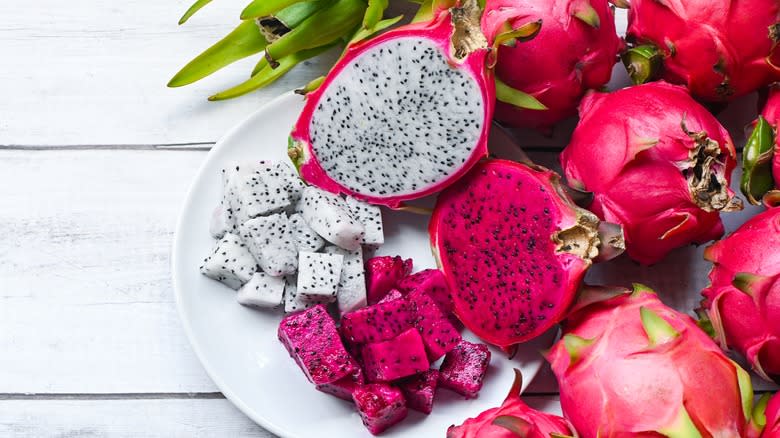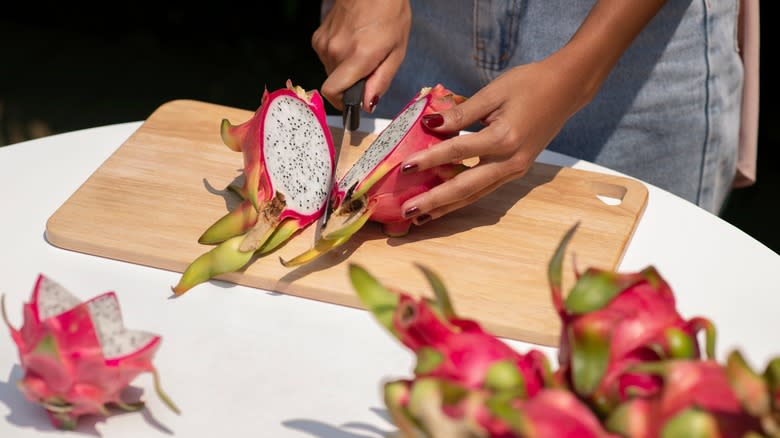The Best Method For Cutting Up Dragon Fruit

There was a time in America when dragon fruit — a fruit of Central and South American origin, otherwise known as pitaya or pitahaya — was all but unheard of. Though its rise is hard to pinpoint, one important moment was when beverage brand Snapple used it as the basis for one of its Elements flavors in the late '90s. Nowadays, dragon fruit is making a big splash. It can be found in many a fruit bowl, at the produce section of just about every grocery store, and in "Dragon Drink" form, where it's become a staple on the menu at Starbucks. If you have never worked with it in your kitchen before, you may be unsure of how exactly to approach slicing it.
The good news is that it's not particularly tricky, but there's plenty of technique involved in getting the most out of your dragon fruit. How fancy you get with your technique depends on what type of dish you are incorporating it into at home, and there are more than a few ways you may want to approach the ol' slice and dice.
Read more: 12 Vegetables And Fruits That Used To Look Very Different
Enter The Dragon

Dragon fruits come in three varieties, with either pink, yellow or red skin. The flesh of the red variety boasts a pleasing magenta hue, while the others are white, but no matter which kind you have on hand, your slicing and dicing methods will be the same.
Before cutting into the fruit, you want to make sure it's ripe. A ripe dragon fruit will have a bit of give to it and a smooth and brightly colored exterior.
Using a sharp knife, slice the fruit in half lengthwise, exposing the interior. To remove the flesh, you can either peel the skin back or scoop it out with a spoon, much like you would with an avocado. The flesh should come out with ease. Another popular method includes slicing off the ends, cutting through the peel, and simply peeling the skin back. With either method, you can get creative with how you choose to carve things up afterwards. Dicing into cubes makes a great option for a mixed fruit bowl, ditto for sphere shapes as well. Those can easily be obtained using a melon baller. And slicing into half moons can add up to an eye-catching visual presentation at your next brunch. If you prefer to enjoy your fruit in a more natural state, the flesh is soft enough to eat with a spoon right out of the skin. Just slice lengthwise and dig in.
You Cut It Up, Now What Do You Do With It?

The flavor of fresh dragon fruit sits somewhere between a kiwi and a pear, with a pleasant-but-mild sweetness to it that can be used in a variety of dishes. Smoothies and dragon fruit juice blends are obvious choices, as it pairs well with many other fruits and even some veggies, but keep in mind that its subtle taste can be easily overpowered by bolder fruits like oranges or lemons, so choose wisely. For a somewhat less traditional use, team the tropical fruit up with berries and balsamic for a dragon fruit and strawberry poke you will be craving on the regular. And if you love cocktails, pureed dragon fruit will throw an unexpected twist into your margarita game with minimal effort.
Dragon-based or not, fruit and desserts will always go hand in hand, and this one works particularly well when used as one of the fruits to top your next cake. You can even use hollowed-out dragon fruit skin as a decorative bowl for things like lemon sorbet, vanilla panna cotta, white chocolate mousse, or whatever else you may dream up. However you slice it, cutting up dragon fruit is sure to get your creative juices flowing!
Read the original article on Daily Meal.

